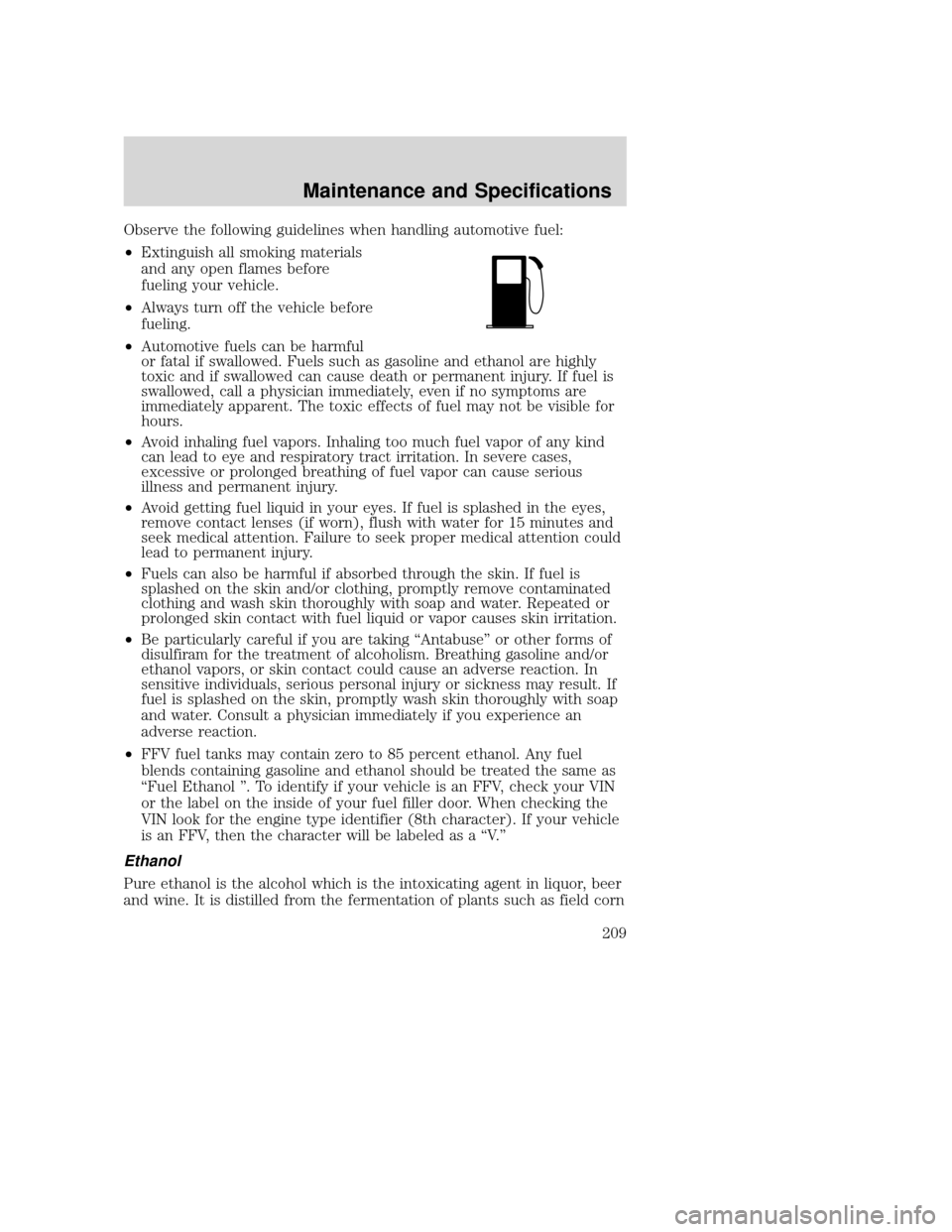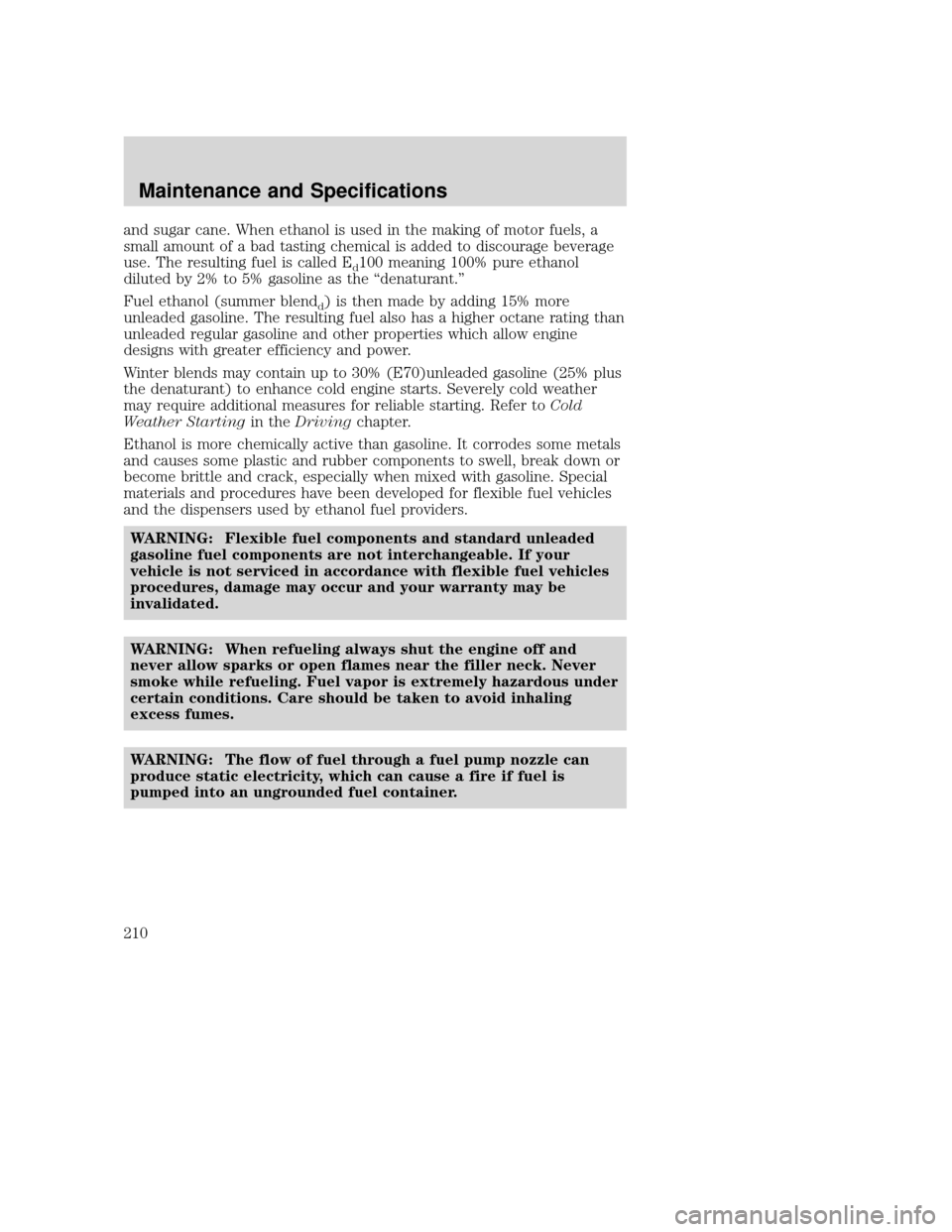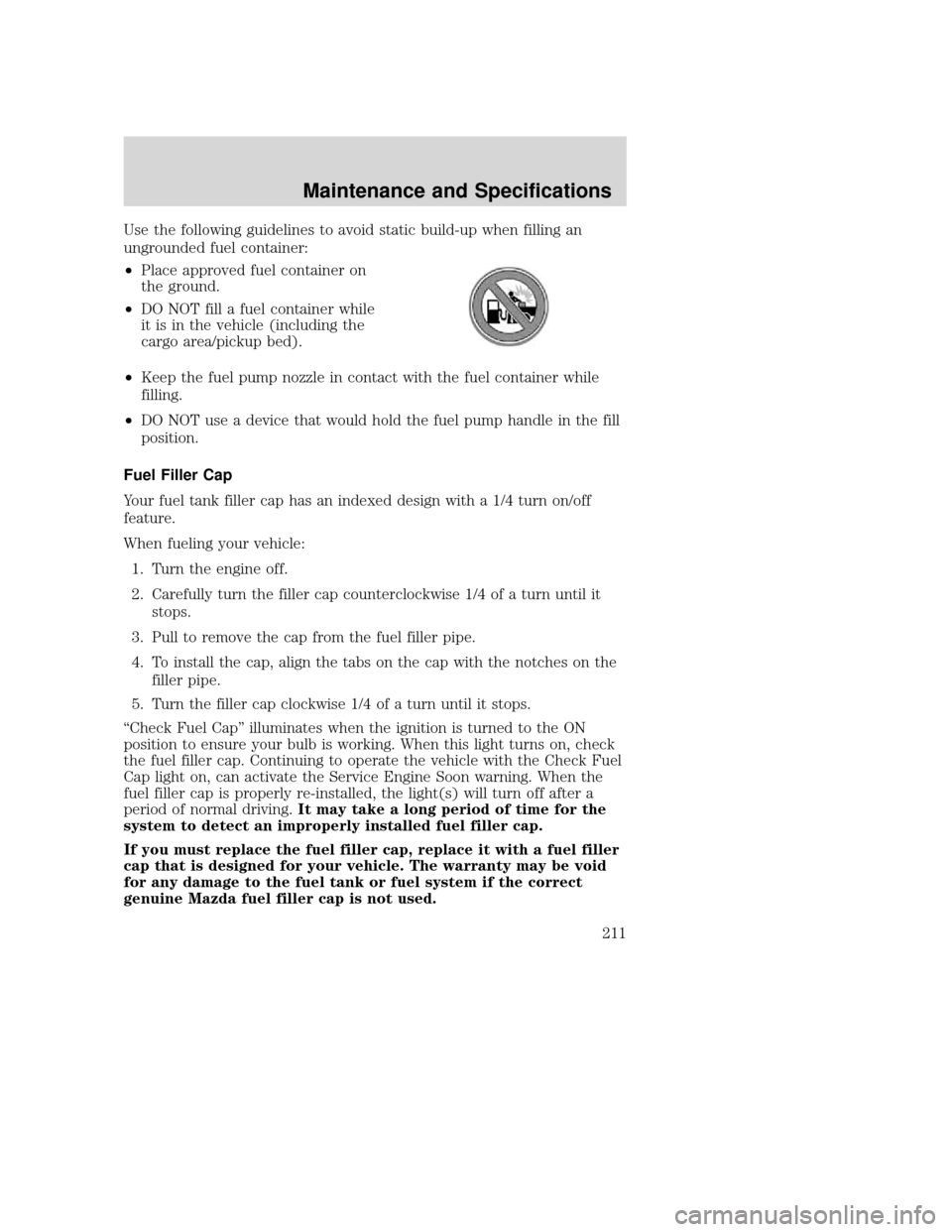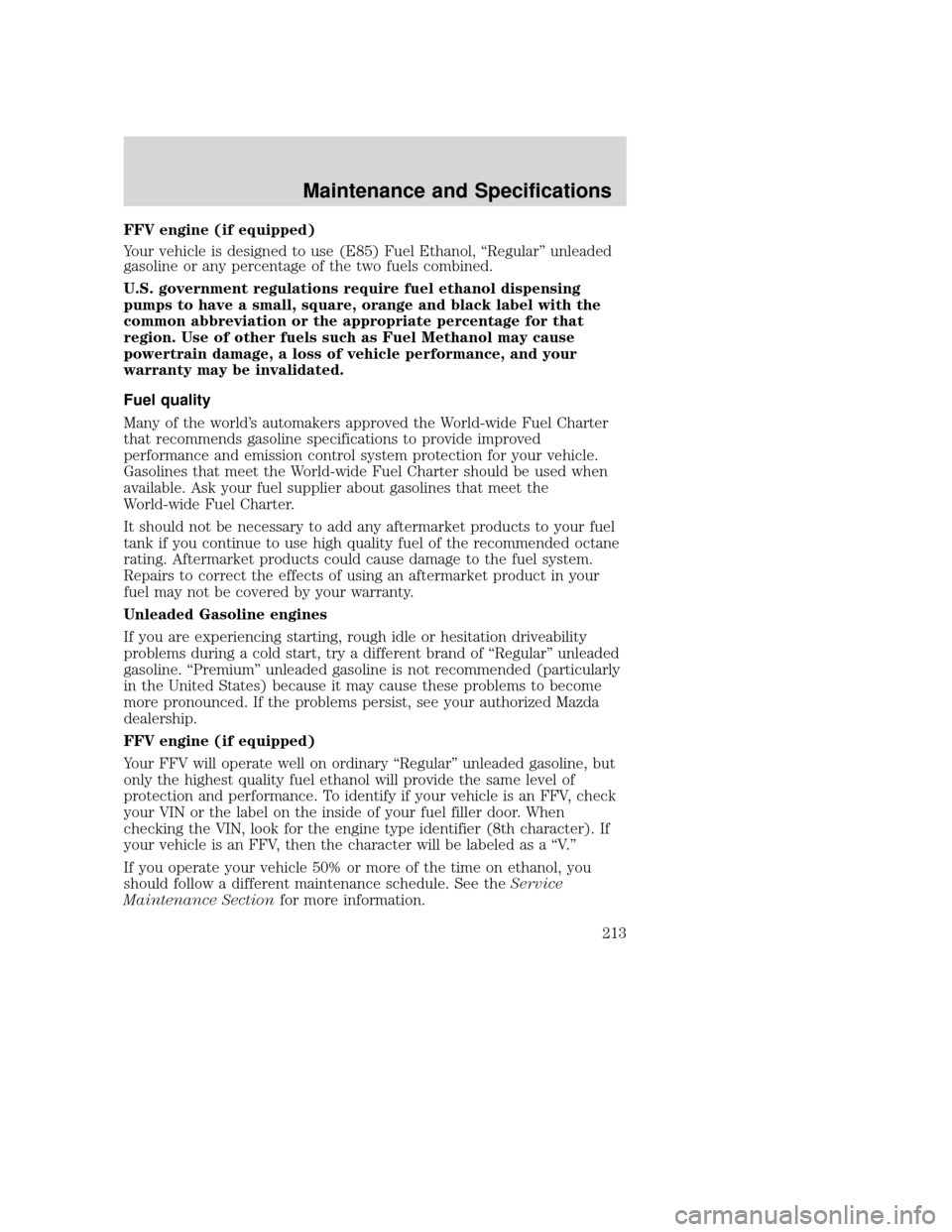engine MAZDA MODEL B-SERIES 2004 (in English) Manual Online
[x] Cancel search | Manufacturer: MAZDA, Model Year: 2004, Model line: MODEL B-SERIES, Model: MAZDA MODEL B-SERIES 2004Pages: 256, PDF Size: 1.97 MB
Page 205 of 256

Plain water may be added in an emergency, but youmustreplace it with
a 50/50 mixture of engine coolant and distilled water as soon as possible.
Check the coolant level in the reservoir before you drive your vehicle the
next few times (with the engine cool). If necessary, add a 50/50
mixture of engine coolant and distilled water to the engine coolant
reservoir until the coolant level is at the “cold fill level”or within the
“cold fill range” as listed on the reservoir (depending upon application).
Have your dealer check the engine cooling system for leaks if you have
to add more than 1.0 liter (1.0 quart) of engine coolant per month.
WARNING: To avoid scalding hot steam or coolant from being
released from the engine cooling system, never remove the
reservoir cap while the engine is running or hot. Failure to
follow this warning may result in damage to the engine ’s cooling
system and possible severe personal injury.
If you must remove the coolant cap, follow these steps to avoid personal
injury: 1. Before you remove the cap, turn the engine off and let it cool.
2. When the engine is cool, wrap a thick cloth around the cap. Slowly turn cap counterclockwise until pressure begins to release.
3. Step back while the pressure releases.
4. When you are sure that all the pressure has been released, use the cloth to turn it counterclockwise and remove the cap.
Recycled engine coolant
Not all coolant recycling processes produce coolant which meets Mazda
specification. Use of a recycled engine coolant which does not meet
Mazda specifications may harm engine and cooling system components.
Always dispose of used automotive fluids in a responsible manner.
Follow your community’ s regulations and standards for recycling and
disposing of automotive fluids.
Coolant refill capacity
To find out how much fluid your vehicle’ s cooling system can hold, refer
to Refill capacities in this chapter.
Fill your engine coolant reservoir as outlined in Adding engine coolant
in this chapter.
2004 Mazda B Series (mbs)
Owners Guide (post-2002-fmt)
Canadian French (fr-can)
Maintenance and Specifications
205
Page 206 of 256
![MAZDA MODEL B-SERIES 2004 (in English) Manual Online Severe climates
If you drive in extremely cold climates (less than–36°C[–34° F]):
• It may be necessary to increase the coolant concentration
above 50%.
• NEVER increase the coolant concentr MAZDA MODEL B-SERIES 2004 (in English) Manual Online Severe climates
If you drive in extremely cold climates (less than–36°C[–34° F]):
• It may be necessary to increase the coolant concentration
above 50%.
• NEVER increase the coolant concentr](/img/28/13731/w960_13731-205.png)
Severe climates
If you drive in extremely cold climates (less than–36°C[–34° F]):
• It may be necessary to increase the coolant concentration
above 50%.
• NEVER increase the coolant concentration above 60%.
• Increased engine coolant concentrations above 60% will
decrease the overheat protection characteristics of the engine
coolant and may cause engine damage.
• Refer to the chart on the coolant container to ensure the
coolant concentration in your vehicle will provide adequate
freeze protection at the temperatures in which you drive in the
winter months.
If you drive in extremely hot climates:
• It is still necessary to maintain the coolant concentration
above 40%.
• NEVER decrease the coolant concentration below 40%.
• Decreased engine coolant concentrations below 40% will
decrease the corrosion protection characteristics of the engine
coolant and may cause engine damage.
• Decreased engine coolant concentrations below 40% will
decrease the freeze protection characteristics of the engine
coolant and may cause engine damage.
• Refer to the chart on the coolant container to ensure the
coolant concentration in your vehicle will provide adequate
protection at the temperatures in which you drive.
Vehicles driven year-round in non-extreme climates should use a 50/50
mixture of engine coolant and distilled water for optimum cooling system
and engine protection.
What you should know about Limp to Safety cooling (2.3L I4
engines only)
If the engine coolant supply is depleted, this feature allows the vehicle to
be driven temporarily to a place of safety. The distance it can be driven
depends on ambient temperatures, vehicle load and terrain, so when the
engine drops into this mode, it is because the engine has overheated and
you need to take special care to avoid it shutting down.
2004 Mazda B Series (mbs)
Owners Guide (post-2002-fmt)
Canadian French (fr-can)
Maintenance and Specifications
206
Page 207 of 256

How Limp to Safety works
If the engine begins to overheat:
•The engine coolant temperature
gauge will move to the red (hot)
area.
• The
symbol will illuminate.
• The “Service Engine Soon”
indicator light will illuminate.
If the engine reaches a preset over-temperature condition, the engine
will automatically switch to alternating cylinder operation. Each disabled
cylinder acts as an air pump and cools the engine.
When this occurs the vehicle will still operate. However:
• The engine power will be limited.
• The air conditioning system will be disabled.
This system has given you an early warning of engine damage and you
should immediately drive to a place of safety where the engine can be
cooled or the vehicle towed to a service shop. Continuing to drive in this
Limp to Safety mode will increase engine temperature some more,
increasing the chance of engine damage, and:
• The engine will completely shut down.
• Steering and braking effort will increase.
If you have decided not to have the vehicle towed, and when the engine
temperature cools, you try to re-start it and it appears to have returned
to normal operation, don’ t delay in getting to a service facility as soon as
possible to diagnose what caused the overheat and prevent further
engine damage.
When Limp to Safety mode is activated
You have limited engine power when in the Limp to Safety mode, so
drive the vehicle with caution. The vehicle will not be able to maintain
high speed operation and the engine will run rough. Remember that the
engine is capable of completely shutting down automatically to prevent
engine damage, therefore:
1. Pull off the road as soon as safely possible and turn off the engine.
2. Arrange for the vehicle to be taken to a service facility.
3. If this is not possible, wait for the engine to cool down.
4. When the engine has cooled down, first check the coolant level. If low, then use a rag and carefully turn the cap one notch
2004 Mazda B Series (mbs)
Owners Guide (post-2002-fmt)
Canadian French (fr-can)
Maintenance and Specifications
207
Page 208 of 256

counter-clockwise carefully to avoid being burned by hot steam.
When there is no steam, keep you face back as you carefully remove
the cap and then replenish the coolant to the full line.
WARNING: Never remove the coolant reservoir cap while the
engine is running or hot.
5. Replace the cap and see if the engine starts and runs normally and drive it to a service place under reduced load and with the air
conditioning off. If it quickly goes into Limp to Safety mode again,
shut it down in a safe location and have the vehicle towed for
service.
WHAT YOU SHOULD KNOW ABOUT AUTOMOTIVE FUELS
Important safety precautions WARNING: Do not overfill the fuel tank. The pressure in an
overfilled tank may cause leakage and lead to fuel spray and
fire.
WARNING: The fuel system may be under pressure. If the fuel
filler cap is venting vapor or if you hear a hissing sound, wait
until it stops before completely removing the fuel filler cap.
Otherwise, fuel may spray out and injure you or others.
WARNING: If you do not use the proper fuel filler cap,
excessive pressure or vacuum in the fuel tank may damage the
fuel system or cause the fuel cap to disengage in a collision,
which may result in possible personal injury.
WARNING: Automotive fuels can cause serious injury or death
if misused or mishandled.
WARNING: Fuel ethanol and gasoline may contain benzene,
which is a cancer-causing agent.
2004 Mazda B Series (mbs)
Owners Guide (post-2002-fmt)
Canadian French (fr-can)
Maintenance and Specifications
208
Page 209 of 256

Observe the following guidelines when handling automotive fuel:
•Extinguish all smoking materials
and any open flames before
fueling your vehicle.
• Always turn off the vehicle before
fueling.
• Automotive fuels can be harmful
or fatal if swallowed. Fuels such as gasoline and ethanol are highly
toxic and if swallowed can cause death or permanent injury. If fuel is
swallowed, call a physician immediately, even if no symptoms are
immediately apparent. The toxic effects of fuel may not be visible for
hours.
• Avoid inhaling fuel vapors. Inhaling too much fuel vapor of any kind
can lead to eye and respiratory tract irritation. In severe cases,
excessive or prolonged breathing of fuel vapor can cause serious
illness and permanent injury.
• Avoid getting fuel liquid in your eyes. If fuel is splashed in the eyes,
remove contact lenses (if worn), flush with water for 15 minutes and
seek medical attention. Failure to seek proper medical attention could
lead to permanent injury.
• Fuels can also be harmful if absorbed through the skin. If fuel is
splashed on the skin and/or clothing, promptly remove contaminated
clothing and wash skin thoroughly with soap and water. Repeated or
prolonged skin contact with fuel liquid or vapor causes skin irritation.
• Be particularly careful if you are taking “Antabuse”or other forms of
disulfiram for the treatment of alcoholism. Breathing gasoline and/or
ethanol vapors, or skin contact could cause an adverse reaction. In
sensitive individuals, serious personal injury or sickness may result. If
fuel is splashed on the skin, promptly wash skin thoroughly with soap
and water. Consult a physician immediately if you experience an
adverse reaction.
• FFV fuel tanks may contain zero to 85 percent ethanol. Any fuel
blends containing gasoline and ethanol should be treated the same as
“Fuel Ethanol ”. To identify if your vehicle is an FFV, check your VIN
or the label on the inside of your fuel filler door. When checking the
VIN look for the engine type identifier (8th character). If your vehicle
is an FFV, then the character will be labeled as a “V.”
Ethanol
Pure ethanol is the alcohol which is the intoxicating agent in liquor, beer
and wine. It is distilled from the fermentation of plants such as field corn
2004 Mazda B Series (mbs)
Owners Guide (post-2002-fmt)
Canadian French (fr-can)
Maintenance and Specifications
209
Page 210 of 256

and sugar cane. When ethanol is used in the making of motor fuels, a
small amount of a bad tasting chemical is added to discourage beverage
use. The resulting fuel is called E
d100 meaning 100% pure ethanol
diluted by 2% to 5% gasoline as the “denaturant.”
Fuel ethanol (summer blend
d) is then made by adding 15% more
unleaded gasoline. The resulting fuel also has a higher octane rating than
unleaded regular gasoline and other properties which allow engine
designs with greater efficiency and power.
Winter blends may contain up to 30% (E70)unleaded gasoline (25% plus
the denaturant) to enhance cold engine starts. Severely cold weather
may require additional measures for reliable starting. Refer to Cold
Weather Starting in theDriving chapter.
Ethanol is more chemically active than gasoline. It corrodes some metals
and causes some plastic and rubber components to swell, break down or
become brittle and crack, especially when mixed with gasoline. Special
materials and procedures have been developed for flexible fuel vehicles
and the dispensers used by ethanol fuel providers.
WARNING: Flexible fuel components and standard unleaded
gasoline fuel components are not interchangeable. If your
vehicle is not serviced in accordance with flexible fuel vehicles
procedures, damage may occur and your warranty may be
invalidated.
WARNING: When refueling always shut the engine off and
never allow sparks or open flames near the filler neck. Never
smoke while refueling. Fuel vapor is extremely hazardous under
certain conditions. Care should be taken to avoid inhaling
excess fumes.
WARNING: The flow of fuel through a fuel pump nozzle can
produce static electricity, which can cause a fire if fuel is
pumped into an ungrounded fuel container.
2004 Mazda B Series (mbs)
Owners Guide (post-2002-fmt)
Canadian French (fr-can)
Maintenance and Specifications
210
Page 211 of 256

Use the following guidelines to avoid static build-up when filling an
ungrounded fuel container:
•Place approved fuel container on
the ground.
• DO NOT fill a fuel container while
it is in the vehicle (including the
cargo area/pickup bed).
• Keep the fuel pump nozzle in contact with the fuel container while
filling.
• DO NOT use a device that would hold the fuel pump handle in the fill
position.
Fuel Filler Cap
Your fuel tank filler cap has an indexed design with a 1/4 turn on/off
feature.
When fueling your vehicle: 1. Turn the engine off.
2. Carefully turn the filler cap counterclockwise 1/4 of a turn until it stops.
3. Pull to remove the cap from the fuel filler pipe.
4. To install the cap, align the tabs on the cap with the notches on the filler pipe.
5. Turn the filler cap clockwise 1/4 of a turn until it stops.
“Check Fuel Cap” illuminates when the ignition is turned to the ON
position to ensure your bulb is working. When this light turns on, check
the fuel filler cap. Continuing to operate the vehicle with the Check Fuel
Cap light on, can activate the Service Engine Soon warning. When the
fuel filler cap is properly re-installed, the light(s) will turn off after a
period of normal driving. It may take a long period of time for the
system to detect an improperly installed fuel filler cap.
If you must replace the fuel filler cap, replace it with a fuel filler
cap that is designed for your vehicle. The warranty may be void
for any damage to the fuel tank or fuel system if the correct
genuine Mazda fuel filler cap is not used.
2004 Mazda B Series (mbs)
Owners Guide (post-2002-fmt)
Canadian French (fr-can)
Maintenance and Specifications
211
Page 212 of 256

WARNING: The fuel system may be under pressure. If the fuel
filler cap is venting vapor or if you hear a hissing sound, wait
until it stops before completely removing the fuel filler cap.
Otherwise, fuel may spray out and injure you or others.
WARNING: If you do not use the proper fuel filler cap,
excessive pressure or vacuum in the fuel tank may damage the
fuel system or cause the fuel cap to disengage in a collision,
which may result in possible personal injury.
Choosing the right fuel
Use only UNLEADED FUEL. The use of leaded fuel is prohibited by law
and could damage your vehicle.
If your vehicle is a flexible fuel vehicle (FFV), use only UNLEADED
FUEL and (E85) FUEL ETHANOL. The use of leaded fuel is prohibited
by law and could damage your vehicle.
Do not use fuel containing methanol. It can damage critical fuel system
components.
Your vehicle was not designed to use fuel or fuel additives with metallic
compounds, including manganese-based additives.
Repairs to correct the effects of using a fuel for which your vehicle was
not designed may not be covered by your warranty.
Octane recommendations
Do not be concerned if your engine
sometimes knocks lightly. However,
if it knocks heavily under most
driving conditions while you are
using fuel with the recommended
octane rating, see your authorized Mazda dealership to prevent any
engine damage.
Unleaded Gasoline engines
Your vehicle is designed to use “Regular”unleaded gasoline with an
(R+M)/2 octane rating of 87. We do not recommend the use of gasolines
labeled as “Regular”that are sold with octane ratings of 86 or lower in
high altitude areas.
87(R+M)/2 METHOD
2004 Mazda B Series (mbs)
Owners Guide (post-2002-fmt)
Canadian French (fr-can)
Maintenance and Specifications
212
Page 213 of 256

FFV engine (if equipped)
Your vehicle is designed to use (E85) Fuel Ethanol,“Regular”unleaded
gasoline or any percentage of the two fuels combined.
U.S. government regulations require fuel ethanol dispensing
pumps to have a small, square, orange and black label with the
common abbreviation or the appropriate percentage for that
region. Use of other fuels such as Fuel Methanol may cause
powertrain damage, a loss of vehicle performance, and your
warranty may be invalidated.
Fuel quality
Many of the world’ s automakers approved the World-wide Fuel Charter
that recommends gasoline specifications to provide improved
performance and emission control system protection for your vehicle.
Gasolines that meet the World-wide Fuel Charter should be used when
available. Ask your fuel supplier about gasolines that meet the
World-wide Fuel Charter.
It should not be necessary to add any aftermarket products to your fuel
tank if you continue to use high quality fuel of the recommended octane
rating. Aftermarket products could cause damage to the fuel system.
Repairs to correct the effects of using an aftermarket product in your
fuel may not be covered by your warranty.
Unleaded Gasoline engines
If you are experiencing starting, rough idle or hesitation driveability
problems during a cold start, try a different brand of “Regular”unleaded
gasoline. “Premium” unleaded gasoline is not recommended (particularly
in the United States) because it may cause these problems to become
more pronounced. If the problems persist, see your authorized Mazda
dealership.
FFV engine (if equipped)
Your FFV will operate well on ordinary “Regular”unleaded gasoline, but
only the highest quality fuel ethanol will provide the same level of
protection and performance. To identify if your vehicle is an FFV, check
your VIN or the label on the inside of your fuel filler door. When
checking the VIN, look for the engine type identifier (8th character). If
your vehicle is an FFV, then the character will be labeled as a “V.”
If you operate your vehicle 50% or more of the time on ethanol, you
should follow a different maintenance schedule. See the Service
Maintenance Section for more information.
2004 Mazda B Series (mbs)
Owners Guide (post-2002-fmt)
Canadian French (fr-can)
Maintenance and Specifications
213
Page 214 of 256

If you are experiencing a rough or rolling idle after start-up with the
outside temperature above 27°C (80° F), the idle should improve within
10 to 30 seconds. If the problems persist below this temperature, see
your authorized Mazda dealership.
Cleaner air
Mazda endorses the use of reformulated “cleaner-burning”gasolines to
improve air quality.
Running out of fuel
Avoid running out of fuel because this situation may have an adverse
affect on powertrain components.
If you have run out of fuel:
• You may need to cycle the ignition from OFF to ON several times after
refueling, to allow the fuel system to pump the fuel from the tank to
the engine.
• Your “Check Engine” indicator may come on. For more information on
the “Check Engine” indicator, refer to the Instrument Cluster
chapter.
Fuel Filter
For fuel filter replacement, see your authorized Mazda dealership. Refer
to the service maintenance section for the appropriate intervals for
changing the fuel filter.
Replace the fuel filter with an authorized Mazda part. The
customer warranty may be void for any damage to the fuel system
if an authorized Mazda fuel filter is not used.
ESSENTIALS OF GOOD FUEL ECONOMY
Measuring techniques
Your best source of information about actual fuel economy is you, the
driver. You must gather information as accurately and consistently as
possible. Fuel expense, frequency of fillups or fuel gauge readings are
NOT accurate as a measure of fuel economy. We do not recommend
taking fuel economy measurements during the first 1,600 km (1,000
miles) of driving (engine break-in period). You will get a more accurate
measurement after 3,000 km –5,000 km (2,000 miles-3,000 miles).
Filling the tank
The advertised fuel capacity of the fuel tank on your vehicle is equal to
the rated refill capacity of the fuel tank as listed in the Refill capacities
section of this chapter.
2004 Mazda B Series (mbs)
Owners Guide (post-2002-fmt)
Canadian French (fr-can)
Maintenance and Specifications
214